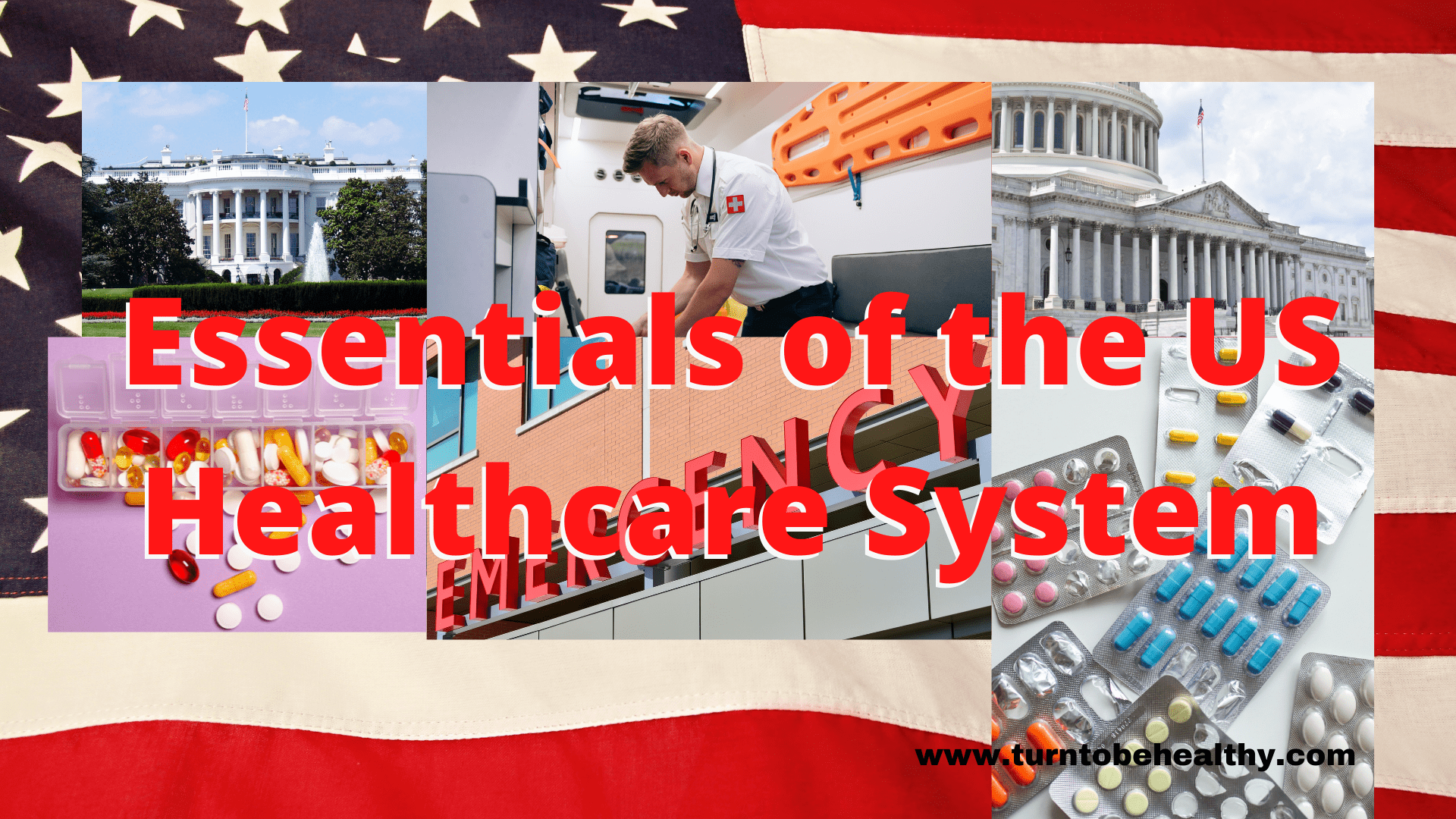Essentials of the US Healthcare System

The essentials of the US healthcare system which is complex and expensive. We’ll cover the basics and some of the industry’s challenges today. We’ll highlight the book, the previous third edition, the fourth edition, and mainly the fifth edition. It’s a clear and concise distillation, a well-organized resource that covers the major characteristics of the health system.
In each new edition, an update of the latest information at that particular time to reflect the current state of the healthcare system. You need to get the latest health statistics to get the newest book.
Table of Contents
The Importance of Health and Health Care
- The U.S. health care system supports the development of new therapies that enhance individuals’ quality of life. It also allows consumers a wide range of options for their healthcare.
- There are several benefits of the U.S. health care system, but there are ways to improve it. These would include lowering costs for individuals, making it easier for more American people to gain access to healthcare, and improving the quality of care, health outcomes, and the health of Americans.
- The US healthcare system is complex, and there are many options available to you to find quality care.
- This edition provides tips on navigating the system and finding the best care for your needs. It included a section on making the most visits to the doctor, including advice on understanding your medical records and getting the most out of your appointments.
- The U.S. health care system supports the development of recent quality initiatives that enhance individuals’ quality of life. It also allows consumers a wide range of options for their healthcare.
- There are opportunities to advance health and access without further growth in spending. To increase efficiency and the provision of health care, the administration has pursued measures that would boost financial incentives for individuals to get consumer-directed health insurance plans.
- In the State of the Union Address, President Obama called for changing the tax treatment of health insurance to give everyone a universal standard deduction. A shift in the way health care is paid for may help to improve the country’s inefficient healthcare system and expand health insurance coverage.
Essentials of the U.S. health care system
The book provides an overview of the historical development of the healthcare system, its key features, and recent changes. It also discusses important issues such as access to care, quality, cost, etc. The book is written by two experts on the U.S. health care system who have many years of experience teaching about it. They explain complex concepts in an easy-to-understand way and provide readers with the essential information to understand this system.
To learn more about the American health care system, this is the book for you!
The US healthcare system is complex, and there are many options available to you to find quality care. This edition provides tips on navigating the system and finding the best care for your needs. Critical infrastructure workers involved in the building and development process, such as inspectors, permits, and plan review services, may be modified to safeguard public health department(s) by allowing qualified private third-party inspections to be held accountable to government agencies.
The U.S. Health Care System
The Patient Protection and Affordable Care Act (ACA) was signed into law by President Barack Obama on 23 March 2010. The ACA is also sometimes referred to as Obamacare. The goal of the Affordable Care Act is to make health insurance more accessible to as many American people as possible while also decreasing the number of uninsured people.
The ACA includes several provisions, or rules, that affect individuals, families, businesses, and states. One of the most important provisions of the ACA is the individual mandate. The individual mandate requires most U.S. citizens and legal residents to have health insurance coverage or pay the penalty.
Another necessary provision of the ACA is the expansion of Medicaid. The growth of Medicaid increases the number of eligible people for Medicaid coverage. The ACA also includes provisions that affect employers. Employers are required to offer health insurance coverage to their employees or pay the penalty.
The ACA also includes provisions that affect states. States are required to establish health insurance exchanges and expand Medicaid eligibility. The US healthcare system is constantly changing, and it can be challenging to keep up with all the latest developments.
This edition of Essentials of the U.S. Healthcare System provides an update of the newest information on the day of the update. It will include anything after in the later revision of the book. The third edition, fourth edition, and fifth edition of this book provide an overview of the U.S. health care system, describing its history, structure, and function. They also discuss important policy issues and changes in recent years. The books are well-written and easy to read, making them ideal for students.
Essentials of the U.S. Healthcare System 3rd Edition 
The third edition book provides an overview of the U.S. health care system, describing its history, structure, and function. It also discusses important policy issues and changes in recent years. In addition, the book provides information on specific aspects of the healthcare system, such as its organization and delivery, financing, and regulation. The book is well-written and easy to read, making it ideal for students.
We recommend the latest book if you are looking for a more comprehensive overview of the US healthcare system. You can buy the book at:
- Amazon
- Barnes & Noble
- Book Depository
- IndieBound
PDF Version: Health Care System Third Edition
- ASIN : 1284035425
- Publisher : Jones & Bartlett Learning; 3rd edition (April 19, 2013)
- Language : English
- Paperback : 376 pages
- ISBN-10 : 9781284035421
- ISBN-13 : 978-1284035421
- Item Weight : 1.19 pounds
- Dimensions : 6 x 1 x 9 inches
Best Sellers Rank: #1,210,588 in Books (See Top 100 in Books)
#298 in Health Care Administration
#310 in Epidemiology (Books)
Amazon Customer Reviews: It is rated at 4.4 starts out of 5 stars from 129 ratings.
Essentials of the U.S. Healthcare System 4th Edition 

You will find this helpful book for anyone interested in learning more about the history of the U.S. healthcare system. This book has an overview of the historical development of the health care systems and its key features. You can buy the book at:
- Amazon
- Barnes & Noble
- Book Depository
- IndieBound
Or you can check out these free samples before deciding if you want to buy them or not:
- Publisher : Jones & Bartlett Learning; 4th edition (May 4, 2017)
- Language : English
- Paperback : 402 pages
- ISBN-10 : 1284126137
- ISBN-13 : 978-1284126136
- Item Weight : 1.31 pounds
- Dimensions : 6 x 1 x 9 inches
Best Sellers Rank: #1,475,954 in Books (See Top 100 in Books)
#381 in Health Care Administration
#1,025 in Accounting (Books)
#1,152 in Financial Accounting (Books)
Amazon Customer Reviews: It is rated at 4.5 starts out of 5 stars from 268 ratings.
Update information on the 5th edition book below to get more updates from this book. The fifth edition of this book provides an overview of the U.S. health care system, describing its history, structure, and function. It also discusses important policy issues and changes in recent years. In addition, the book provides information on specific aspects of the healthcare system, such as its organization and integrated delivery system, financing, and regulation. The book is well-written and easy to read, making it ideal for students.
Essentials of the US Healthcare System 5th Edition

This fifth edition book is an overview of the historical development of the health care system, its key features, and recent changes. You can buy the book at:
- Amazon
- Barnes & Noble
- Book Depository
- IndieBound
Or you can check out these free samples before deciding if you want to buy them or not.
PDF Version : Health Care System Fifth Edition
- Publisher : Jones & Bartlett Learning; 5th edition (September 21, 2018)
- Language : English
- ISBN-10 : 1284174972
- ISBN-13 : 978-1284174977
- Item Weight : 1.19 pounds
- Dimensions : 6 x 1 x 8.75 inches
Best Sellers Rank: #2,412,025 in Books (See Top 100 in Books)
#1,750 in Health Care Delivery (Books)
#1,826 in Accounting (Books)
#1,890 in Financial Accounting (Books)
Amazon Customer Reviews: It is rated at 4.5 starts out of 5 stars from 501 ratings.
This fifth edition book got 14 chapters and covers major topics covered and is laid out as shown below:
- Chapter 1 – Major Characteristics of the U.S. Health Care Delivery
- Chapter 2 – Foundations of the U.S. Health Care Delivery
- Chapter 3 – Historical Overview of the U.S. Health Care Delivery
- Chapter 4 – Health Care Providers and Professionals
- Chapter 5 – Technology and its Effects
- Chapter 6 – Financing and Reimbursement Methods
- Chapter 7 – Outpatient Services and Primary Care
- Chapter 8 – Hospitals
- Chapter 9 – Managed care and Integrated Systems
- Chapter 10 – Long-term Care Services
- Chapter 11 – Populations with Special Health Needs
- Chapter 12 – Cost, Access, and Quality
- Chapter 13 – Health Policy
- Chapter 14 – The Future of Health Services Delivery
This book is a comprehensive guide to the U.S. healthcare system and its complexities. It is well-written and easy to read, making it ideal for students. The book provides an overview of the u.s health care system’s history, structure, function, and recent policy changes.
The book is a fantastic resource for anybody who wishes to get more information about u.s health care system. The new Sixth Edition of Essentials of the U.S. Health Care System will be published in August 2022. This book is a clear and concise distillation of the major topics covered in the Delivering Health Care in America: A Systems Approach 8th Edition, written by the same authors.
The text breaks down the intricacies of health care organization and finance and provides a comprehensive description of how all elements relate. This thorough revision includes updates throughout to reflect the major changes in the Affordable Care Act.
You can also buy the essentials of the U.S. book is available in various formats, such as:
- eTextbook
- Hardcover
- Paperback
- You can buy it either used or new
- Kindle
- Audiobook
Health Care Organization (HCO)
The HCO is a term used in the US to describe businesses or enterprises whose primary purpose is to deliver healthcare services. The HCO sector in the United States comprises a wide range of:
- Small to Large Hospital
- Small to Large Clinics
- Home Health Care Agencies
- Businesses or Organizations Involved in Providing Finances
- Businesses or Organizations Involved in Administering Health Care Services, etc.
The HCO sector multiplied since the 1980s due to the growth of managed care, which led to increased competition among providers. These have caused some hospitals to consolidate their operations into more extensive facilities that are better equipped to handle large volumes of patients.
In the early 21st century, the HCO sector was dominated by a relatively small number of enormous for-profit organizations.
IN RECENT YEARS, the HCO sector has been characterized by significant change and consolidation. Hospitals have been merging with physician groups, forming ever-larger healthcare networks. These networks have become increasingly important as healthcare delivery has shifted from a fee-for-service model to insurers willing to pay only for care delivered through an accountable care organization (ACO) or another integrated system.
Health care administrators’ decisions have significant consequences on the quality of patient care.
Affordable Care Act (ACA)
The Affordable Care Act, also known as Obamacare or the Patient Protection and Affordable Care Act (PPACA), is a United States federal law enacted in 2010. It was signed into law by President Barack Obama on 23 March 2010. The bill attempts to ensure that all Americans have access to affordable health insurance coverage.
The ACA has had a profound impact on the US health care system, and it is still being implemented. The law has expanded coverage to millions of Americans who were previously uninsured, and it has also made numerous changes to how health insurance is sold and regulated.
The ACA is expected to significantly impact the US health care system for years to come. The act established several new programs, including Medicaid expansion, subsidies for private insurance plans, tax credits for individuals and families purchasing insurance, and penalties for those without insurance.
Over the next five years, the ACA will provide $11 billion to expand and develop community health centers.
- The HRSA’s $1.5 billion investment will help community health centers nationwide develop their facilities and pay for significant construction and renovation work.
- $9.5 billion will:
- Expand health essential services at existing community health center sites, including preventive, health outcomes, and
- Primary care services include oral care, behavioral health, pharmacy, and/or enabling services.
With health care costs continuing to rise at an unsustainable rate, and quality not yet ideal, healthcare is still inaccessible to millions of people. The Children’s Health Insurance Program (CHIP) and the Patient Protection and Affordable Care Act (ACA) policies have extended affordable health care coverage to millions of people previously uninsured, non-Medicare eligible individuals and children during the previous two decades.
However, the rollback of certain aspects of these plans had driven up the percentage of uninsured to 15.5%, roughly where it was ten years ago when our uninsured rate was nearly 17%, and over 50 millions of people were without coverage. To get toward a healthier and more productive society, making sure that everyone in the United States has affordable health care coverage with a defined list of state’s EHB-benchmark plan is critical.
Everyone will have affordable healthcare coverage providing equal access to age-appropriate and evidence-based healthcare services. To provide health care coverage for everyone, the AAFP advocates for bipartisan solutions that adhere to the above criteria, have a majority of support from Americans, and include one or more of the following strategies, with the understanding that each has its advantages and drawbacks:
- A bi-partisan approach to financing recognizes the need for a diverse health care system.
- The organization’s goal and health care delivery system is to provide consumer-driven, cost-effective coverage that includes competition based on quality, price, and service.
A guarantee that all people would have access to affordable health care coverage must be a part of such a strategy.
KEY COMPONENTS OF THE APC-APM PAYMENT
The American Academy of Family Physicians’ Policy Framework is a powerful tool for the AAFP to lead the US toward a primary care-based healthcare system in which patients are treated as partners, with their well-being in mind:
- Everyone deserves high-quality, low-cost healthcare.
- All people are provided a medical home
- All people have primary care-oriented benefits.
However, this does not guarantee that everyone in the United States has access to high-quality health care.
Economic and Clinical Health Integration (ECHI)
It is a new approach to the integrated delivery system of health care services that has been developed by the National Institute for Health Research (NHS). It aims to improve patient experience, reduce costs and increase efficiency in the NHS by integrating clinical care and essential public health services.
The concept of ECHI has been developed in response to the growing recognition that healthcare delivery is complex and that it must consider the many factors that affect both the quality and cost of care. The ECHI program was launched on 1 April 2014 and is designed to support local plans to integrate clinical commissioning groups and other organizations across the country.
ECHI is a relatively new concept, and there is still much disagreement and challenges about how it should be defined and operationalized. It is based on the principles of integration, collaboration, and partnership between government and private sectors, such as commissioners, providers, people using services, etc.
At its most basic, ECHI is the integration of clinical care and essential public health services with economic goals. Another way to achieve ECHI is to invest in information technology (IT) systems that support the delivery of coordinated, patient-centered care.
Take note that ECHI is not the same as clinical integration, a process by which individual providers work together to coordinate care for their patients. ECHI goes beyond clinical integration by including the economic goals of reducing costs and improving quality.
Health Information Technology for Economic and Clinical Health (HITECH)
The HITECH Act, passed in 2009 by the US government, is a significant component of the administration’s plan to encourage widespread health information technology adoption (HIT).
The HITECH Act includes several provisions designed to encourage the use of HIT, including:
- Conditions to increase the use of electronic health records (EHRs).
- Incentives for the benefit of certified EHRs.
- Requirements for the privacy and security of health information.
The HITECH Act also created the Office of the National Coordinator (ONC) for HIT, responsible for coordinating federal efforts to support HIT adoption. This act authorizes $27 billion over five years to help states develop electronic medical records (EMRs), computerized provider order entry (CPOE), and other forms of health IT.
The bill requires the Secretary of Health and Human Services to develop a nationwide certification program for certified EMRs and CPOEs. The connection between pharmacy and public health is evident in the goal of the Healthy People 2030 objectives, which are to improve clinical management of chronic diseases, health education, primary disease prevention/control programs, and partnerships with state and local governments.
National and state’s recent quality initiatives to reduce healthcare costs. Government and private-sector efforts to improve the quality of health care, as well as cost containment programs. Access to treatment, quality of care, and health outcomes are all affected by racial and socioeconomic health disparities. There are also national, regional, and local campaigns targeting those gaps.
Pharmacists and student pharmacists must be allowed to work toward these objectives because health education, disease prevention, population health, and interprofessional learning are essential components of Doctor of Pharmacy programs.
There are growing demands for health care workforce challenges due to population health and the necessity for chronic disease managers. The authors looked at the 21 qualifying studies. Their results were classified into three categories depending on the LCS pipeline’s stages in which racial and socioeconomic disparities are anticipated or known to occur.
Economic and Clinical Health Outcomes of the First-Generation Versus Second-Generation Antipsychotic Drugs for Schizophrenia
Antipsychotics are a class of drugs that have been used to treat schizophrenia since the 1950s, but there is still no cure for the disorder. The first-generation antipsychotic drugs were developed in the 1950s and 1960s and effectively treated the positive symptoms of schizophrenia, such as hallucinations and delusions.
However, these drugs also caused several severe side effects, including movement disorders (e.g., involuntary movements called dyskinesias), weight gain, and changes in blood sugar levels.
Global Health Care Spending
Its spending reached $7.5 trillion in 2017 and is projected to increase to $10.5 trillion by 2025. The United States accounts for the largest share of global healthcare spending, accounting for more than one-third of total expenditures in 2017.
China is the second-largest spender on healthcare, accounting for nearly 20% of global spending in 2017. The countries with the fastest growth in healthcare spending are India and Indonesia, which are expected to see double-digit growth rates from 2017 to 2025.
Find out what Marketplace health insurance plan cover
All Marketplace plans must cover the essential health benefits, but some states may have chosen to add additional benefits. Each state’s marketplace will list the essential health benefits covered by that state’s plan(s).
What are the various sorts of health coverage plans?
There are four main types of health insurance plans:
- Fee-for-Service (FFS) Plans
- HMOs
- POSs
- PPOs
Essential Health Benefits(EHB) Benchmark Plan
The following are all essential health benefits that marketplace provides plans must cover:
- Laboratory services
- Habilitative services and devices
- Pediatric dental and vision services
- Outpatient mental health and substance abuse services
- Prescription drugs
- Rehabilitative services
- Emergency care
- Hospitalization
- Maternity and newborn care
However, each state has the option to develop their state’s EHB-Benchmark plan to add additional benefits, if they want. The state’s EHB-benchmark plan is the set of 10 essential health benefits that must be covered by all Marketplace plans in a given state.
All plans offered in the Marketplace cover these 10 EHB benchmark plans:
- Ambulatory patient services are the type of care you get when you don’t have to stay in the hospital.
- Emergency services
- Hospitalization (such as surgery and extended stays)
- During pregnancy, newborn care, breastfeeding, and other issues related to the baby’s development
- Treatment for mental health and substance use disorders, such as behavioral health treatment (this includes counseling and psychotherapy)
- Prescriptions for medicine
- Rehabilitative and habilitative treatments and technologies are used to aid individuals with injuries, disabilities, or chronic diseases in regaining or optimizing their mental and physical abilities.
- Services in a laboratory
- Preventive and wellness services keep you healthy while chronic disease management aids in the treatment of diseases.
- Pediatric services, dental and vision benefits are covered (but adult dental and vision coverage aren’t required)
The state’s EHB-benchmark plan is not the same as the Essential Health Benefits Package, a package of benefits that varies from one state to another. For example, in California, the Essential Health Benefits Package covers more essential public health services than the state’s EHB-benchmark plan. In addition, the state’s EHB benchmark plan can vary based on your income level.
You must decide whether you want to buy a single policy or a family plan. Separate policies usually cost less per month than family plans, but they only cover you if you’re single. Family plans cover everyone in your household regardless of age or marital status. They also offer greater flexibility because you can change your plan without going through underwriting.
The benchmark plans are the most common type of plan offered by employers and insurers. They offer a set level of benefits for employees at a fixed price, usually with no out-of-pocket costs. The employer pays the premium to an insurance company, and the employee receives a check every month.
state’s EHB-Benchmark plan IS available in two types:
• Self-funded plans
These plans are typically used by large companies that pay a portion of the premiums themselves and then pass along the rest to employees.
• Third party-administered plans
These plans are administered by an insurance company and paid for by employers and employees. In both cases, the employer decides what benefits it wants to provide. Most employers choose to offer medical, dental, vision, life, disability, and long-term care benefits.
Some employers may also include supplemental benefits like an accident, critical illness, and legal liability insurance. The requirement to calculate the state’s EHB benchmark Plan, the only requirements to cover specific care, treatment, or services, are considered when evaluating State-required benefits (or mandates).
For state’s EHB benchmark Plan coverage purposes, any requirements that the plan must reimburse certain health care professionals who provide covered service within their scope of practice are not treated as State-required benefits.
Similarly, State-mandated benefits are not considered when calculating your total family benefits package. Dependent mandates, for example, require defining dependents in a specific way or covering dependents under certain circumstances (e.g., newborn cover, adopted children, domestic partners, and disabled children).
Finally, State anti-discrimination laws prohibiting service delivery methods (e.g., telemedicine) are not considered State-required benefits.
Public Health Infrastructure
Public Health Infrastructure is a term used in the United States to describe the public health infrastructure, including hospitals and clinics, laboratories, disease surveillance systems, emergency response services, environmental protection programs, and other agencies of the U. S. Department of Health and Human Services.
The goal of the Public Health Infrastructure is to protect and improve the health of all Americans by providing leadership and direction for public health activities, promoting partnerships with other organizations, and supporting state and local efforts. The Public Health Infrastructure includes:
A. Health Departments
B. Hospitals
C. Clinics
D. Laboratories
E. Disease Surveillance Systems
F. Emergency Response Services
G. Environmental Protection Programs
H. Other Federal Agencies Involved in Public Health Activities
I. State and Local Public Health Organizations
J. Non-governmental Organizations Involved in Public Health Activities
The Public Health Infrastructure is overseen by the U. S. Department of Health and Human Services, which is responsible for setting priorities and funding public health activities. The department has several agencies that play a role in public health, including the Food and Drug Administration, the Centers for Disease Control and Prevention, the National Institutes of Health, and the Substance Abuse and Mental Health Services Administration.
State and local governments also have a role in public health through their health departments and other organizations. In addition, there are many non-governmental organizations involved in public health, such as professional associations, foundations, voluntary health organizations, and educational institutions.
Frequently Asked Questions About the Essentials of the U.S.
What are the ten characteristics of the US healthcare system?
- There isn’t a single governing body to oversee everything, and integration and coordination are poor.
- Technology-driven delivery system focusing on acute care.
- Unequal access, high cost, and average outcome.
- Delivery of health care in an imperfect market environment.
- The public sector is a subsidiary of the private sector.
- Market and social justice are combined.
- Multiple players but a delicate balance of power.
- The pursuit of accountability and integration.
- Individually targeted health care services depending on insurance coverage.
- Legal risks influence practitioner behaviors.
In what capacity should the federal government play a role in offering Americans with health care?
The government should have a role in ensuring that all Americans have access to affordable health care, but the specifics of that duty are debatable. Some people believe that the government should provide primary health care. In contrast, others believe that the government should only provide financial assistance to those who cannot afford health care.
There is no right or wrong answer; simply analyze the advantages and disadvantages of each choice before making a selection.
What are some of the challenges facing the US healthcare system?
There are many challenges facing the US healthcare system, including rising health care costs, an aging population, and increasing numbers of American people with chronic conditions. In addition, the US healthcare system is complex and fragmented, which makes it challenging to coordinate care and ensure that everyone has access to the essential public health services or facilities they need.
What is single-payer health care?
Single-payer health care is a system in which the government pays for all medical expenses, but patients still have the choice of which doctor or hospital they want to use. There is only one insurance company in a single-payer system, and the same plan covers everyone.
What role should the marketplace play?
The healthcare market should play a part in the US system, but the specifics of that role are disputed. Some people believe that the marketplace is the best way to ensure that people have access to quality care, while others believe that the marketplace creates too many barriers to care and leads to higher costs.
There is no wrong or right answer, but it’s important to think about the advantages and drawbacks of each option before making a selection.














